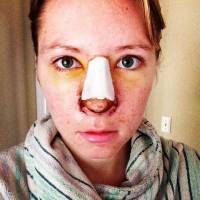Removing Nose Bump
Yes, it is definitely possible to smooth out a lump on the bridge of the nose without breaking it. However, this is not a matter of just finding the right surgeon to perform the surgery that way; it depends on if you are a candidate.
Whether or not your surgeon is able to take this approach centers around the physical structure of your nose. If you are interested in this possibility, take the time to find an excellent rhinoplasty specialist who is a board certified plastic surgeon, and who’s willing to listen to your preferences.
From there, your surgeon can give you an exam to determine whether filing the bump away is going to give you the best results. (John Alexander II, MD, San Diego Plastic Surgeon)
It depends on how much of the bump needs to come down and whether it is just bone or bone an cartilage. Most nasal humps are both. The cartilage must be carefully trimmed as the bone is filed. If the bump on nose is small, it may be possible to avoid osteotomies. However, imagine a long tent; and you take off the top of the tent. You are now left with the walls of the tent separated by air and a ridge post (in this case the nasal septum) down the middle.
To avoid what is called an “open roof deformity” the side walls of the tent (here, the nasal bones) must be cut to let them collapse a bit towards each other and close the gap.
The surgeon will need to decide at the time of surgery whether or not to do osteotomies. In most cases, they are are needed if the bump was large. (Stuart H. Bentkover, MD, Boston Facial Plastic Surgeon)
Remove bump on nose
Yes, you can Remove bump on nose without breaking the nose. This involves filing off the dorsal (top of the nose) bump deformity to eliminate for reduce the bump.
You will need to have a consultation with a plastic surgeon so you can find out if you are a good candidate for this specific procedure. (Jeffrey W. Hall, MD, Austin Plastic Surgeon)
Rhinoplasty Surgery & Removal bump on nose
The management of nasal bumps varies from patient to patient and depends on the patient’s aesthetic goals and anatomic findings. In some cases, removal of nasal bumps can be accomplished without breaking the nose. When this scenario occurs, the dorsal hump is usually small and the procedure doesn’t result in widening of the nasal bridge.
In the vast majority of patients who have nasal bumps removed, fracture of the nasal bones is necessary to prevent widening of the nasal bridge. When large bumps are encountered, the bumps consist of cartilage and bone. Under these circumstances, removal of large nasal bumps can result in a phenomenon known as an open roof deformity.
The only way to correct this nasal bridge widening is to fracture the nose along the base of the nasal bridge. If you’re considering rhinoplasty surgery and removal of a dorsal hump, consultation with a board certified plastic surgeon would be an appropriate step. Your surgeon should be able to determine whether nasal infracture will be necessary to correct your nasal hump. (Richard J. Bruneteau, MD, Omaha Plastic Surgeon)
Reducing a dorsal hump without infracturing the bones.
It is possible to reduce a small dorsal hump without infracturing the nasal bones; however, most of the time that I reduce a dorsal hump I do infracture the nasal bones. This is done to prevent the appearance of a flat nose or an ‘open roof deformity’. In general, one should not fear having their bones in fractured. It is not a traumatic procedure and is done in a controlled manner with minimal discomfort. (Sanjay Grover, MD, Orange County Plastic Surgeon)
Removivg bump on nose (Dorsal Hump) without Breaking the Nose Bones
This is a more complicated question than it may seem. In general, removing bump on nose (dorsal hump) involves taking out a part of the septum, upper lateral cartilages, and nasal bones.
This leaves a separation between the two side of the nose (sometimes called an open roof). In some cases, this creates a palpable defect or even a flat-looking nose. For bumps that are mostly cartilage, or pretty small, the open roof may not be noticeable. In these cases, infracturing (breaking) the nose bones can be avoided. Best of luck going forward! (Evan Ransom, MD, Bay Area Facial Plastic Surgeon)
The Nose Does Not Always Need to be Broken After Rhinoplasty…
Rhinoplasty is a complex operation that can involve many interacting forces within the nose. If the bump is very small, it can be filed down without “breaking” the nose.
But if there is any size to the bump at all, the bones need to be brought in to give the nasal bridge a normal shape again. Typically this is done with very fine instruments so there is not much trauma involved.
The nose usually heals up great and it doesn’t even look like it was broken. I understand that fracturing of the nose during rhinoplasty can make one nervous, but if necessary, it definitely creates the best result. (Andrew Miller, MD, Edison Facial Plastic Surgeon)
Nose bump removal without breaking the nose
In about 50% of our cases, we are able to perform nose bump removal without breaking the nasal bones. This is done by placing cartilage grafts in the hollowness left where the bone was removed.
Also, some mini postage stamp bone nicks can be made to narrow the nose without breaking the nose. So called postage stamp osteotomies. (Pramit Malhotra, MD, Ann Arbor Plastic Surgeon)
Nose bump removal without breaking the nasal bones
Nasal osteotomies, or ‘breaking the nose’, during rhinoplasty understandably creates pre procedure anxiety for every patient and is a common question during every consultation.
Breaking the nose, in general, is required if the nose is crooked or if there is a large hump or wide bridge. If there is subtle hump and a narrow bridge then occasionally, osteotomies can be avoided but in most cases, an osteotomy on on or both sides is required. If the hump alone is removed, the new hump must look balanced with the old tip.
If your plastic surgeon feels this will not be the case, he or she may recommend reducing the size of the tip or raising the tip to make the profile or frontal view of the your nose look better. (Mike Majmundar, MD, Atlanta Facial Plastic Surgeon)
Seek a Rhinoplasty Specialist
Not all rhinoplasty surgery requires “breaking the nose”. That part of rhinoplasty is called an osteotomy and usually used to narrow the nose after bringing down the hump of the nose.
The reason to perform an osteotomy is if the nose is too wide after bringing the bridge down. Evaluation by a rhinoplasty specialist will help determine the best method and results for your nose. Not all patients require osteotomies (“breaking the nose”). (Jacob D. Steiger, MD, Boca Raton Facial Plastic Surgeon)
Removing Nose Bump without Breaking the Nose
I usually recommend against taking down a bump on a nose without following that with osteotomies. There are very few noses that allow for this to be done and for the bridge to appear natural.
As disconcerting of a thought as it is, fracturing the nasal bones in my opinion makes for a natural smooth end result.
That does not mean that the bridge of your nose needs to be significantly lower but that the width of the nasal bones needs to be brought in to create the new triangular anatomy of your altered bridge. I would need to see pictures in order to make the determination. (George T. Moynihan, MD, Chicago Facial Plastic Surgeon)
Nose bump removal
This depends on the size of the bump on your nose. If the bump in your nose is too large, it may not be possible. However, you need to consult with an expert facial plastic surgeon to ensure the best possible results for your procedure. (Carlo Honrado, MD, FACS, Los Angeles Facial Plastic Surgeon)
Nose bump removal without breaking the bones is possible.
Nose bump removal without breaking the bones can be done by filing down the bone. If the bump is small, and your nose does not need straightening, then it may not be necessary to break the bones. I would consult with a rhinoplasty expert to determine if this is possible. (Richard A. Zoumalan, MD, Los Angeles Facial Plastic Surgeon)
Removing a hump on the nose
The term that includes filing down the hump on the nose is called “rasping” and is a technique that is used during rhinoplasty.
If the hump is subtle this is typically sufficient to address that area. However, for larger humps, they need to be removed with a more involved technique.
Once this is completed, the nasal bones usually need to be broken and moved closer together to prevent what is called an “open roof deformity” where the nose can look wide and flat.
Rhinoplasty typically costs anywhere between $6,000-$10,000 depending on whether you live. (Michael T. Somenek, MD, FACS, Washington DC Facial Plastic Surgeon)
Removing a hump on the nose.
This is one of the most common reasons patients want rhinoplasty. It is very unusual to just remove the bump. This may be possible if it is very small.
Most often nose hump removal will require removal of excess bone and cartilage. The nasal bones widen as they near the face so lowering the bridge of the nose will usually make the bridge wider and may also expose hidden irregularities like a crooked septum.
If the bridge is lowered it will most often be necessary to narrow the nasal bones by performing osteotomies ( breaking the nose) to narrow the bridge back to its original width or close to it. The lower part of the bridge of the nose is cartilage of both the bridge and the tip cartilages so lowering the bridge will also often require removing a small amount of tip cartilage.
What is most important to learn from this information is that doing something to one part of the nose a will effect how other parts look and to get the best, most natural results will usually require doing something to all parts of the nose.
This probably seems confusing because altering one part of the nose changes the appearance of the whole nose makes rhinoplasty one of the most difficult cosmetic procedures performed.
Look for a surgeon who performs many rhinoplasties each year and who can thoroughly explain the procedure to you during your consultation. (William H. Sabbagh, MD, Detroit Plastic Surgeon)
Removing a dorsal hump without an osteotomy
The answer to this is based on the anatomy and judgement of your surgeon. There is no one right answer. If the bump is small or mostly cartilagenous, then it would be possible. In most insatnces, nose hump removal without an osteotomy leaves an open roof deformity which gives a flat and operated look to the nose.
In today’s world of external osteotomies, the bruising, pain and downtime is minimal. There should be no reason not to perform osteotomies if there would be an improvement in the appearrance of the nose. (Paul E. Chasan, MD, Del Mar Plastic Surgeon)
Removal of dorsal nasal hump sometimes requires ‘breaking’ the nose
A small dorsal nasal hump can be removed through and open or closed rhinoplasty approach without ‘breaking’ the nasal bones. For large dorsal hump reductions, the act of nose hump removal leaves the top of the nose ‘open’ (open roof deformity) which needs to be fixed by moving the nasal bones toward the dorsal midline, thus helping to close the structures along the top of the nose. (Scott C. Sattler, MD, FACS, Seattle Plastic Surgeon)
Minimally Invasive Rhinoplasty, Hump Reduction
There are some patients that can be treated to reduce a dorsal hump without technically performing osteotomies. Osteotomies are precise cuts made in the top and sides of the nose to release the bones and facilitate narrowing.
If a patient has a minimally elevated bump on the top (dorsum) of the nose without a particularly wide nasal bone structure, the surgeon will likely choose an endonasal (no outside incisions on the skin) approach for rasping or sanding down of the excess height of the nose. This may be all that is required in your case. However, it should be noted that two things may occur with this approach:
- Patients can develop a boxy top appearance to the nose referred to as an “Open Roof Deformity.” This is a risk of lowering the dorsum without narrowing the bones.
- Patients may be at risk to develop a nasal appearance that is not in harmony. The lowered dorsum may arbitrarily cause an overly wide appearance of the nasal bones that have not been adjusted.
This is a decision that really takes years of experience to fully follow with a very qualified surgeon. You are correct to ask this very valuable question but I would strongly recommend taking the advice of your surgeon very seriously. He or she will help you select the least invasive and simplest methods for achieving your goals. (Todd Christopher Hobgood, MD, Phoenix Facial Plastic Surgeon)


